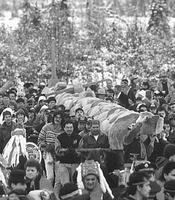Nisga'a
NISGA'A ( ) are a FIRST NATIONS people occupying the valley of the NASS R in northwest BC. Their language is usually considered to be the northern usage of Nass-Gitksan, but for political reasons is sometimes referred to as a distinct idiom (see FIRST NATIONS LANGUAGES; TSIMSHIAN). When the first European explorers arrived at the mouth of the river in 1793 an estimated 8,000 people were living in the Nass Valley. Epidemic diseases reduced that number to less than 900, but since the 1920s the population has recovered. The 2005 population was about 6,000, 2,500 of whom lived in the 4 main villages of Gingolx (KINCOLITH), Laxqalts'ap (GREENVILLE), Gitwinksihlkw (CANYON CITY) and GITLAKDAMIKS (New Aiyansh). The rest lived outside the territory. The Nisga'a are organized socially into 4 matrilineal totemic clans: KILLER WHALE, WOLF, RAVEN and EAGLE. Clans are further divided into houses, or wilps, which hold rights to songs, dances, names and territories. The people occupied villages of CEDAR plank houses (see ARCHITECTURE, ABORIGINAL) and engaged in elaborate winter ceremonies, including the POTLATCH. They subsisted on the SALMON and EULACHON fisheries, plus hunting and gathering. Extensive trading networks deep into the Interior linked them with their GITKSAN relatives and other neighbouring groups. Today FISHING and LOGGING are the main employers, though unemployment in the valley is high. The tradition of wood carving has been revitalized and Nisga'a TOTEM POLES by master carvers such as Norman TAIT and his brother Alver are again being raised in traditional Nisga'a territory and as far away as VANCOUVER, Chicago, England and Australia (see ART, NORTHWEST COAST ABORIGINAL). The Nisga'a were the first aboriginal group to initiate a legal land claim against the government (see ABORIGINAL RIGHTS), sending a delegation to Victoria in 1887. After repeated rebuffs they appealed in a 1913 petition directly to the Privy Council in England, contending that they had never surrendered their territory and asking for recognition of their aboriginal title. In 1955 they formed the Nisga'a Tribal Council to unite the 4 clans in pursuit of their claim. Led by Chief Frank CALDER they initiated another legal case in 1969 (see CALDER CASE) that ended at the Supreme Court of Canada. Though the court ruled against the Nisga'a in a split decision, it recognized the principle of aboriginal title and brought about a fundamental shift in government policy. In Aug 1998 the Nisga'a finally initialled a historic treaty settlement with the provincial and federal governments (see NISGA'A TREATY).
Reading: Nisga'a Tribal Council, Nisga'a: People of the Nass River, 1993.
-
Video
-
Internet links

